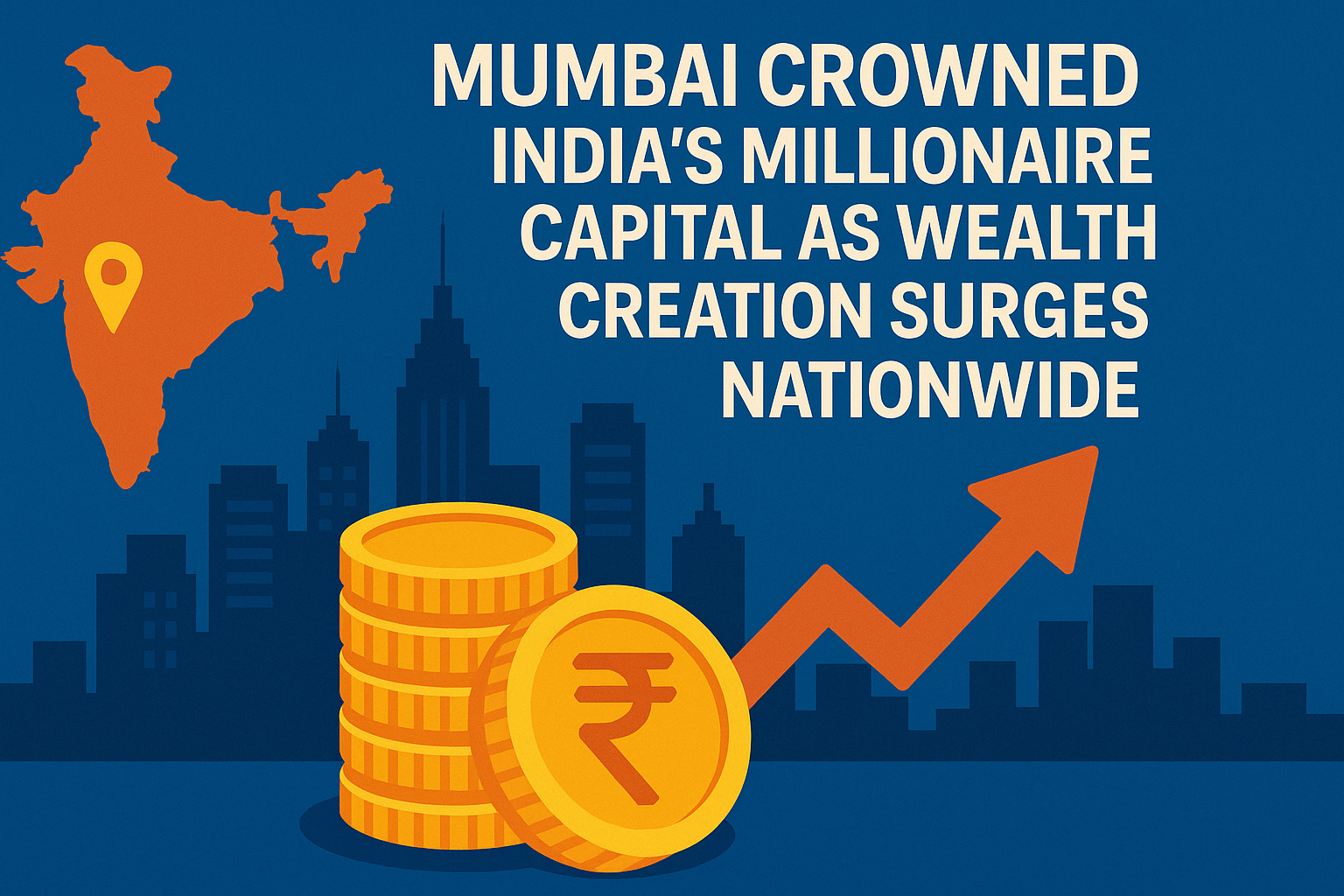
Mumbai Crowned India’s Millionaire Capital as Wealth Creation Surges Nationwide
The numbers are in, and they are staggering. The Mercedes-Benz Hurun India Wealth Report 2025 has officially declared Mumbai the “Millionaire Capital of India,” leading the country with 1,42,000 millionaire households. Maharashtra as a whole accounts for 1,78,600 such families—an almost 200% jump from 2021. This rise is not just about luxury cars and sea-facing apartments; it is a reflection of how India’s economic fabric is being rewoven through stock markets, real estate, gold, and a confident middle-to-rich class transition.
A 200% Leap in Millionaire Households
India today has 8,71,700 millionaire households, defined as those with a net worth of ₹8.5 crore ($1 million) or more. In 2021, that number stood at 4,58,000. In just four years, wealth creation has doubled. To put it in perspective, this group now represents 0.31% of Indian households—a small share, but a rapidly expanding one.
Between 2017 and 2025, millionaire households grew by 45%, while the Nifty 50 jumped nearly 70% and gold prices almost doubled. In short, this is not accidental wealth; it is wealth built on compounding markets, rising property values, and the cultural affinity Indians retain for gold as a store of value.
Mumbai at the Helm, Delhi in Pursuit, Bengaluru on the Horizon
Mumbai, unsurprisingly, tops the millionaire charts. As the financial capital of India, home to the Bombay Stock Exchange, Dalal Street powerhouses, and a thriving entrepreneurial class, the city now houses 1,42,000 millionaire households.
Delhi follows with 68,200 households, riding on its booming real estate, service-sector wealth, and a politically connected ecosystem. Bengaluru, India’s Silicon Valley, secures the third spot with 31,600 millionaire households—a figure that underlines the rise of new-age wealth creators from technology, startups, and venture capital.
Globally, this transformation is not going unnoticed. The World’s Wealthiest Cities Report 2025 placed Bengaluru at 3rd for millionaire growth (120% rise over a decade), while Delhi (82%) and Mumbai (69%) also ranked among the fastest-growing hubs worldwide.
What’s Driving the Surge?
The story of wealth creation in India is multi-layered:
- Equities Boom: Indian stock markets have been robust, with the Nifty 50 up nearly 70% since 2021. This has created not just billionaires but an entire layer of first-generation millionaires.
- Real Estate Upswing: Rising urbanization and property valuations—particularly in Mumbai, Delhi NCR, and Bengaluru—have multiplied household net worth.
- Gold’s Timeless Lure: With prices almost doubling, gold has once again served as the hedge of choice, making Indian households wealthier on paper and in sentiment.
- UPI Revolution: Interestingly, UPI-based payments have overtaken cards and cash even in luxury transactions. This digital-first trend shows that India’s wealthy are not just asset-heavy but also tech-savvy.
The Wealth Mindset: Aspirations and Caution
The Hurun report does more than count millionaires; it dissects their mindset. A conservative streak runs through India’s wealthy class. While 29% actively manage their wealth, only 17% embrace risk. A larger 31% adopt a cautious, preservation-first approach. The preferred overseas destination for investments? The United States, followed by the UAE, reflecting a blend of security and diaspora connectivity.
Interestingly, when asked what it takes to feel “financially free,” answers varied:
- 27% said ₹50 crore,
- 25% settled at ₹10 crore,
- 20% raised the bar at ₹200 crore.
This spread illustrates that wealth is as much about psychology as it is about balance sheets.
How the Rich Spend
For all the focus on wealth accumulation, the spending patterns of India’s millionaires are not as extravagant as stereotypes suggest. About 60% spend under ₹1 crore annually, with the largest portions going toward tourism, education, and entertainment. These choices indicate not just consumption but investment in experiences and human capital.
On social responsibility, 30% of respondents said paying taxes is their top priority. This is significant: it signals a shift from philanthropy as vanity to taxes as nation-building. Environmental causes (20%) and charity (17%) followed closely.
Maharashtra’s Muscle
Maharashtra’s rise as India’s millionaire hub is rooted in more than just Mumbai’s dominance. The state’s GSDP has risen 55% to ₹40.5 lakh crore ($480 billion) in just four years, driven by services, manufacturing, and finance. The wealth base is wider than before—no longer just about industrial barons but also professionals, stock traders, and startup founders.
Delhi and Tamil Nadu also showed significant growth, highlighting that wealth creation is not restricted to one geography but is a national trend. Together, the top 10 states account for 79% of India’s millionaires.
Beyond the Numbers: What It Means for India
The doubling of millionaire households is not merely a story about the rich. It represents the deepening of India’s financial ecosystem, the success of digital platforms like UPI, and the resilience of its economy through global volatility. It is also a story of aspiration—ordinary citizens looking at extraordinary growth and wondering how to join the club.
At the same time, the cautious risk appetite and relatively frugal spending habits show that wealth in India is still tethered to a conservative cultural mindset. The new rich may drive luxury car sales and global travel, but they remain careful custodians of their fortunes.
Final Word
The Hurun India Wealth Report 2025 is not just a roll call of millionaires. It is a mirror of India’s economic trajectory—more confidence, more creation, more concentration in hubs like Mumbai and Delhi, but also a spreading culture of financial literacy and wealth aspiration.
If Mumbai today is the “Millionaire Capital,” the bigger story is that India is becoming a land of opportunity where more citizens see the path from middle-class to millionaire as not just possible, but increasingly probable.





